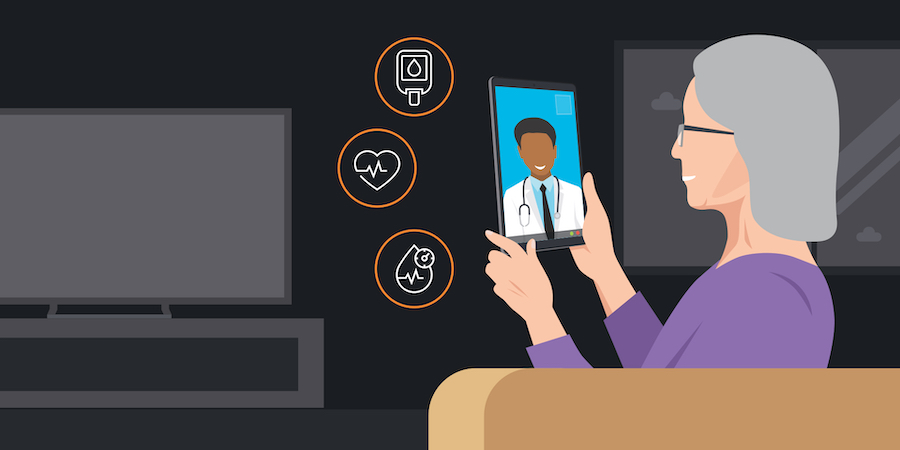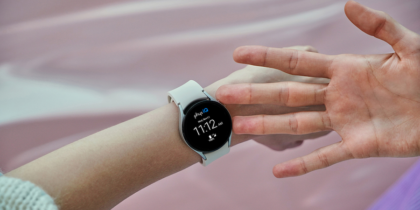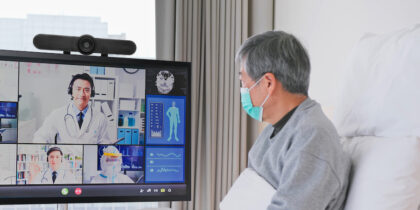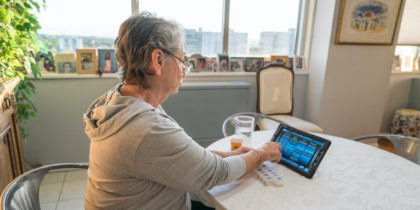Remote patient monitoring (RPM) was a fast-growing healthcare trend even before COVID-19 made it a necessity. Now that more providers and patients have experienced the benefits of RPM, 43 percent of healthcare leaders believe remote monitoring will be as ubiquitous as in-person RPM by 2026, and 35 percent think it will surpass in-person monitoring by then, according to a 2021 VivaLNK survey.
For hospitals, RPM is an effective way to improve post-acute care and reduce hospital readmissions. For physicians, it’s a new tool for chronic care management and a way to increase reimbursement from the Centers for Medicare and Medicaid Services (CMS). And for health insurers — the newest market for remote monitoring — it’s a means of improving patient outcomes and overall population health, which ultimately saves everyone money.
Regardless of your use case, the key to a successful RPM launch is thoughtful planning. You have big decisions to make — like which patient populations you should monitor and which remote monitoring solutions you should use. But if you plan well and choose the right partners, implementation is fairly simple and mostly managed by your vendors, with minimal effort from your IT staff.
Before launching or upgrading your remote monitoring program, you need to know where to start and what questions to ask in the first stages.
1. Which patient populations would benefit most from RPM?
Most leading remote monitoring platforms are flexible enough to work for a variety of clinical use cases — like providing post-acute care after surgery, supervising chronic care management for conditions like congestive heart failure or asthma and guiding patients through lifestyle changes such as weight loss, smoking cessation or addiction recovery. But different RPM solutions are better suited to different use cases.
Before choosing a vendor, you should know which conditions are on your RPM wish list — now and for the future. Otherwise you might end up with a solution that doesn’t meet all your needs.
It also helps to know which patient populations are top priority for remote monitoring so you can roll the technology out in stages and not overwhelm clinical staff.
2. Who should own the hardware?
Some RPM vendors have traditionally offered Bring Your Own Device (BYOD) solutions that let patients use their personal smartphones or tablets to enter information and receive notifications from an app. But such solutions often lack the necessary security and prove difficult to manage and support.
Today’s vendors typically install their software on preconfigured mobile devices that patients use exclusively for the monitoring program. The devices are locked down and containerized, with a streamlined user experience that works for patients of all ages. This method also allows providers to make better use of the sensors in the device and add functionality, such as push-button emergency calls or fall detection. Plus, for Medicare patients, physicians get CMS reimbursement for dedicated devices.
3. What’s the best form factor?
The best RPM solution is one your patients will actually use. Just as RPM software should meet all your clinical needs, the hardware should be a good fit for the patient populations you’ll monitor. Many leading remote monitoring vendors offer their solution on various types of devices, or plan to do so in the near future. Others don’t, so it’s important to know what you want before choosing a vendor.
Wearable RPM devices are one of the latest healthcare trends, and many vendors now offer smartwatch-based solutions. New research from Johns Hopkins shows that wearable accelerometers (sensors that track movement) measure activity levels more accurately than patient surveys. Wearable monitors are also a better predictor of death risk in seniors than traditional metrics such as age, smoking, alcohol use and history of heart disease or cancer.
Still, wearables aren’t the only effective way to gather patient data. Most modern smartphones also have accelerometers, and depending on your use case, activity level might be an important data point for you to collect. If patients need to answer questions or type in information, a tablet or larger smartphone might be easier for them to use. And according to a new study by the University of Pennsylvania, patients who use smartphone-based RPM solutions transmit health data for longer periods of time compared to patients who use other form factors.
4. Which RPM vendors should you use?
Not all RPM vendors are created equal. They all have the same function — enabling physicians to remotely monitor patient data — but they do it in different ways, using different devices at different scales.
Choosing from this wide playing field of vendors can be daunting. Start by seeking guidance from colleagues who have already implemented remote monitoring, as well as technology partners who have relationships with remote monitoring providers — such as device manufacturers and cellular carriers.
How to build a successful remote patient monitoring program
Discover the RPM solutions and best practices that transform the patient experience and improve health outcomes. Download Now
As you’re evaluating RPM solutions, ask vendors about these factors:
- Company background: How long have you been in business? How many healthcare organizations do you currently serve? Do you have case studies that demonstrate your clients’ results? Do you have use cases like ours?
- Scalability: How many patients will your solution serve? How easy is it to scale our patient load up or down?
- Electronic health records (EHR) integration: Can your solution be integrated with our organization’s EHR?
- Physician experience: How do physicians receive data? What insights can they get from your platform? Can they receive automated alerts about troubling trends in patient data?
- Patient outcomes: How does your solution improve patient outcomes and decrease hospital readmissions? Do you have case studies with data that illustrates these benefits?
- Hardware: Does your solution include customized devices? If so, how much do you mark up the devices? If not, can you help us procure quality devices at an affordable rate?
- Kitting/provisioning: Who provisions devices and kits the solution? Who ships them to patients’ homes? Is there anything our IT team will need to do?
- Cost versus return on investment (ROI): What’s the cost of your solution? What’s the ROI that you provide customers?
- Support: Who provides tech support to patients? Who provides customer service?
- Privacy/security: How do you secure patient data? Have you ever experienced a data breach? Is your solution HIPAA-compliant?
5. How can you control the costs of RPM?
Implementing remote monitoring often requires more than one partner. Along with a software provider, you’ll need a cellular carrier and possibly a device manufacturer. Depending on the scale of your remote monitoring program, you might also need a reseller capable of purchasing large volumes of devices and/or a HIPAA-compliant mobile device management (MDM) solution to secure the devices.
The key to a successful and cost-effective launch is finding vendors who will work together to ensure a seamless implementation and who will bundle products and services to offer a better price. Mobile devices, for example, can be one of the most expensive components of a remote monitoring solution, especially if your vendor doesn’t include devices and you have to buy them at market price. However, if you purchase devices through a cellular carrier and sign a contract for data service, the price drops dramatically. And you’re going to need that data anyway.
Done right, RPM improves patient outcomes and saves your organization money. If you’re a physician, it can even make you money. The trick to doing it right is finding partners who understand the challenges that healthcare organizations and physicians face, have the relationships in place to optimize costs and know how to make implementation as seamless as possible.
After that, the hard part is over. You can sit back and let your partners do the heavy lifting.
How smart are your clinical communications? Find out with this free, quick assessment. Or, learn more about the RPM solutions that can save you time and money, and keep your organization moving.








